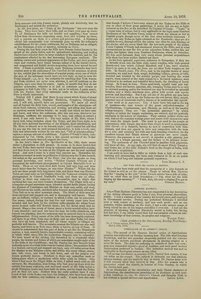< "Isis Unveiled" and the Todas (continued from page 7-97) >
the Madras to the Malabar coasts, and within this every village, mountain, hill, river, and brook is laid down, and all the jungles and forests perfectly known. Nowhere is there any untrodden nook or hiding-place where a mysterious white tribe could be hidden. Also when I first knew the Nilgiri Hills in 1843, I talked much with an old surveyor, Mr. Macmahon, then living, who had gone up there with the earliest European explorers, and surveyed much of the hills before asingle European house had been built on them, and he found the Todas just as they are now. Neither from the early settlers have I ever heard of any white Todas, nor have the Badagas, who have been on the hills for four centuries, any tradition of such. I must here also note that though I believe I have seen almost all the Todas on the Hills atone or other of their great gatherings, I never did see any so light-colored as the five or six described by Captain O'Grady. “Light” is a vague term of colour, but is very applicable to the high-caste Namburi Brahmans of the Western Coast, many of whom are almost as fair as English people, though never of the true clear northern whiteness. I never saw any Todas so light-coloured as the Namburis; they are of a reddish-brown, through which the colour can often be seen flushing on the cheeks, and are never black like the low-caste people of the plains. I wish Captain O’Grady had mentioned where on the Hills, and in what circumstances he saw the five or six colourless Todas, neither fair nor ruddy, but lighter than even Namburi Brahmans, whom he describes. He was more fortunate than very many whose personal acquaintance with them has been neither limited nor short.
As for their splendid goparams, unknown to Europeans, if they are to dwindle down into the little rude, round temples, with high-peaked thatch-roof, into which Colonel Marshall, and I too, have crawled, there’s no more to be said, for there are no other Toda temples on the hills. In Tieck’s story, The Elves, and in the popular stories of many countries, we read how dark, rough, forbidding valleys, groves, or hills, dreaded and avoided by the country people, and bearing the worst repute, when entered at the right season by a favoured wanderer, were disclosed to be radiant and beautiful fairy-lands, the dwelling of lovely beings. So it may be here. These mud-built, squalid huts and hut temples, these red-brown, ignorant, idle, lounging Todas, may be so only in outward seeming, and to the favoured eye may be revealed as splendid temples, and a white, wondrous race, gifted with occult and mystic powers and knowledge. But I am not one of the gifted, my eyes have not been unveiled, and to me the Todas are the red-brown, dirty, stupid, ignorant race of inveterate loafers, known so to multitudes like myself.
One word as to goparams. Yes. I have been into and to the top of numbers—the vast towers of the great cathedral-temples of Chellumbrum, Combaconum, and Madura, as well as of the smaller village-temples. They are u the pyramidal gateways” by which temples, or rather the temple enclosures, are entered, and are perfectly analogous to the towers of churches. They contain neither shrine nor idol, and are the common resting-place and resort of all classes who may not enter the temple itself. The word is not used by the people as synonymous with temple, any more than steeple is used as synonymous with church: it is Sanscrit, having no sort of connection with Hindustani, and does not appear to have any connection with the term for a cow, and certainly not with any term denoting roundness, for the excellent reason that Hindu towers or gateways are never round. Moreover, the goparam is not sacred; it signifies a city gateway just as much as a temple gateway, and the former is its primary meaning. The authoress of Isis Unveiled must be familiar with goparams, and know all this. At any rate, she will find all about Hindu Temples, and Gurus too, in the Abb6 Dubois’s book on the People of India, with which she is acquainted.
I am sorry to have had to differ so widely from a lady of such rare learning and attainments, but have only ventured to do so on points on which I had long and intimate personal experience.

In Every Thing Gide Thanks
Literary Accuracy
Sir,—That Madame Blavatskyhas not exaggerated in her description of the fishing alligator pools in India I can, from personal observation, testify. I was a resident of that country for several years, and employed in Government service. During my periodical furloughs I travelled over a wide extent of territory, and saw such pools; and on one occasion, whilst sketching on the shore, I had a very narrow escape of being seized by one of the largest crocodiles I ever saw. I had not the pleasure of knowing Madame Blavatsky whilst in India, but, having met her here, I can safely assert that her conversation evinces an intimate knowledge of that country, its peoples and religions.
(Late Architect to the Government, Bombay Presidency).
No. 1, Union-square, New York, March 19th, 1878.
Gossip from New York
...
Editor's notes
Sources
-
London Spiritualist, No. 295, April 19, 1878, p. 190

